-
Article tells you about the origin of Kangra paintings, patronage by Kangra ruler, themes, style and features.
HistoryKangra
painting is the pictorial art of Kangra, named after Kangra, Himachal Pradesh, and
a former princely state, which patronized the art. It became prevalent with the
fading of Basohli School of painting in the mid-18th century, and soon produced
such a magnitude in paintings both in content as well as volume, that the
Pahari painting school, came to be known as Kangra paintings.
In the middle of the 18th century A.D. when the plains of Northern India were
convulsed by the invasion of Nadir Shah (1739), followed by the incursions of
Ahmad Shah Abdah, a strange event took place in the Punjab hills viz. the birth
of the Kangra School of Painting at Haripur-Guler under the patronage of Raja
Govardhan Chand (1744-1773), a prince with a refined taste and passion for
painting.
He
gave asylum to refugee artists trained in the Mughal Style of painting. In the
inspiring environment of the Punjab Himalayas with their beautiful green hills,
wave-like terraced paddy-fields and rivulets fed with the glacial waters of the
snow-covered Dhauladhar.
The
Mughal style with its sensitive naturalism blossomed into the Kangra style.
Instead of painting flattering portraits of their masters and hunting scenes,
the artists adopted themes from the love poetry of Jayadeva Bihari and Keshav
Das who wrote ecstatically of the love of Radha and Krishna. Thus, was developed
a school of painting with a new spirit, whose artistic works are suffused with
romantic love and bhakti mysticism.
SuccessorsParkash
Chand (ruled 1773-1790), the successor of Govardhan Chand, also continued the
patronage of the artists.
The
paintings in early Guler style were by the artist Pandit Seu and his two sons
Nainsukh, Manak and brother Gursouhae were employed by Raja Parkash Chand of
Guler.
Raja
Sansar Chand (1775-1823) attracted a number of talented artists from the court
of Guler even when he was 20 years of age. He was the most renowned Raja in the
Kangra Valley and was the most generous patron of the art of painting.
It
was under his patronage that Jaydeva’s Sanskrit love poem, the “Gita Govinda”,
“Bihari’s Sat Sai”, “Bhagawat Purana”, the romantic tale of Nala and Damyanti,
and Keshav Das’s Raskapriya and Kavipriya were translated into paintings of
exquisite beauty. Manku, Khushala Kishan Lal, Basia, Purkhoo, Fatoo are
mentioned as artists in the employment of Sansar Chand.
These
artists did not mention their names on the painting which also shows their
selfless devotion to the art.
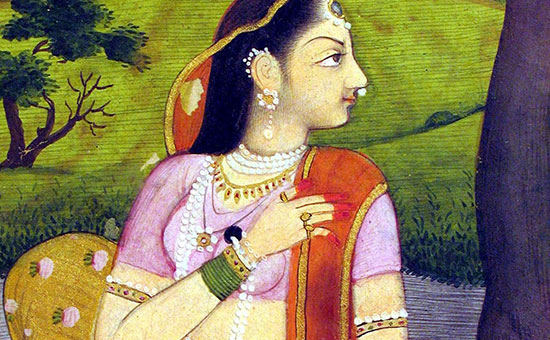
ThemesTo
turn to the techniques of Kangra Painting, its chief features are delicacy of
line, brilliance of color and minuteness of decorative details, like the art of
Ajanta,
Kangra
art is essentially an art of the line. This imaging delicacy and fineness of
the line was achieved by the use of fine brushes made from the hair of
squirrels.
The Kangra painters made use of pure colours like yellow, red and blue and these have retained the brilliance, even after two hundred years. The central theme of Kangra painting is live and its sentiments are expressed in a lyrical style full of rhythm, grace and beauty. The recurring theme of Kangra painting whether it portrays one of the six seasons or modes of music, Radha and Krishana or Siva and Parvati is the love of man for woman and of woman for man.
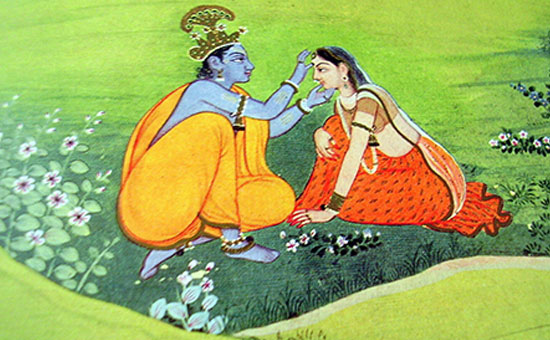 Sri Krishna and Radha.
Sri Krishna and Radha.
The
three main centers of Kangra painting are Guler, Nurpur and Tira-Sujanpur.
Painting
depicts ideas and values which guided life in society, sentiments and passions
pictured in the language of brush and color making our experience rich and
sensibilities sharp.
Miniatures
are steeped in religious faith as they depict Puranic tales and stories from
Ramayana and Mahabharata in minute detail. Sensitive depiction of literary
works Rasik Priya, Sat Sai and Rasmanjari, Geet Govinda and other works refer
to the awareness of people.
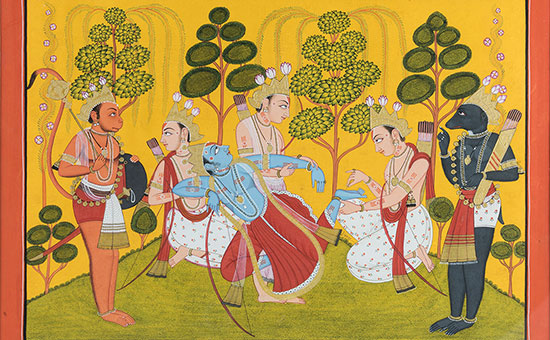 Sri Ram & Hanuman ji.
Sri Ram & Hanuman ji.
The
episodes are most eloquent, colours most vibrant, brilliant and soft. The brush
is tender. Nature is depicted as sublime. Animal & birds find place
wherever necessary.
The
Nayika of miniature is Radha, the
most beautiful woman on earth characterized by feminine grace and Porcelain
delicacy and Nayak is none other than the blue God Krishna. We also see the
hill Rajas modelling for the Nayak. Portraits of hill Rajas give us a glimpse
into their character, likes and attributes. But for
the liberal patronage available this art would not have touched such High
levels of excellence.
StyleIn
Kangra painting we find a mix of folk styles in Rajput, Mughal and Punjabi. As
Aurangzeb drove the Hindu artists of his court from the state, they took
shelter in neighbouring states. This art has grown from them has many styles.
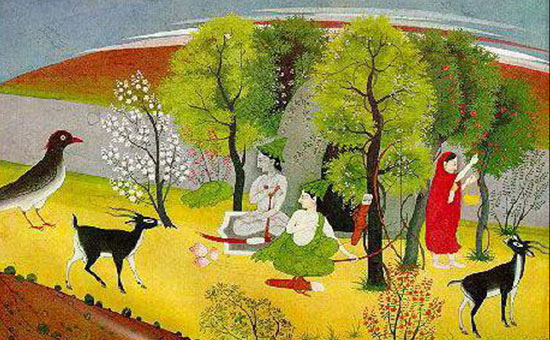
Features of Kangra paintingOne
striking feature of Kangra paintings is the verdant greenery it depicts. The
style is naturalistic, and great attention is paid to detail. The foliage
depicted is vast and varied. This is made noticeable by using multiple shades
of green. The Kangra paintings feature flowering plants and creepers, leafless
trees, rivulets and brooks.
The
Kangra artists adopted various shades of the primary colors and used delicate
and fresher hues. For instance, they used a light pink on the upper hills to
indicate distance.
Kangra
paintings depict the feminine charm in a very graceful manner. Facial features
are soft and refined. The female figures are exceptionally beautiful.
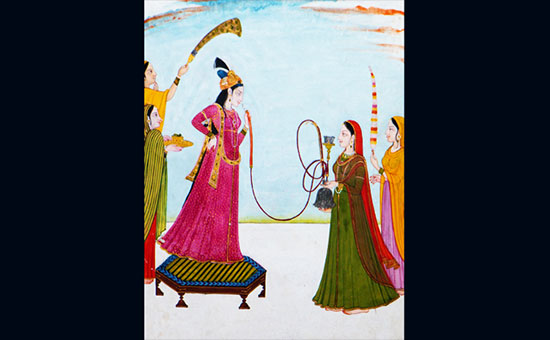
Later
Kangra paintings also depicted nocturnal scenes, storms and lightning. The
paintings were often large and had complex compositions of many figures and
elaborate landscapes. Towns and house clusters were often depicted in the
distance.
The Kangra painters used colors made of vegetable and
mineral extracts. They employed cool and fresh colors. Kangra paintings
are known for the lyrical blending of form and color.
Motivation
The
Kangra painting is unique to the place where it was born and raised. The
pictures are inspirational to the hills. The shade of that area is visible in
the wooden bins. The plot is a touch of folk tales. Kangra is meaningful
because of this colorful background.
AccessibilityMcLeodganj,
along the road from the main square to the Dalai Lama temple are souvenir shops
and trinket stalls. There may once have been a time when these businesses sold goods
that were unique to the region, but, over the years, most of their wares have
acquired a pan-national character.
In
the chaos of modern commerce, objects harking back to centuries-old tradition
can be hard to sell, and yet, this is precisely the task that the Kangra Arts
Promotion Society (KAPS), an NGO, has been quietly working at for the last
decade. On the walls of its gallery in McLeodganj, an airy space with windows
offering stunning views of the valley below, are exquisite paintings in the
300-year-old Kangra painting tradition.
Author is a Mumbai based artist.
The
purpose of this compilation is to document and promote. We have given credits
and reference links in this compilation. In case some are missed, it is not
with malafide intent.
To read all
articles by author
To
see album on Basholi Paintings